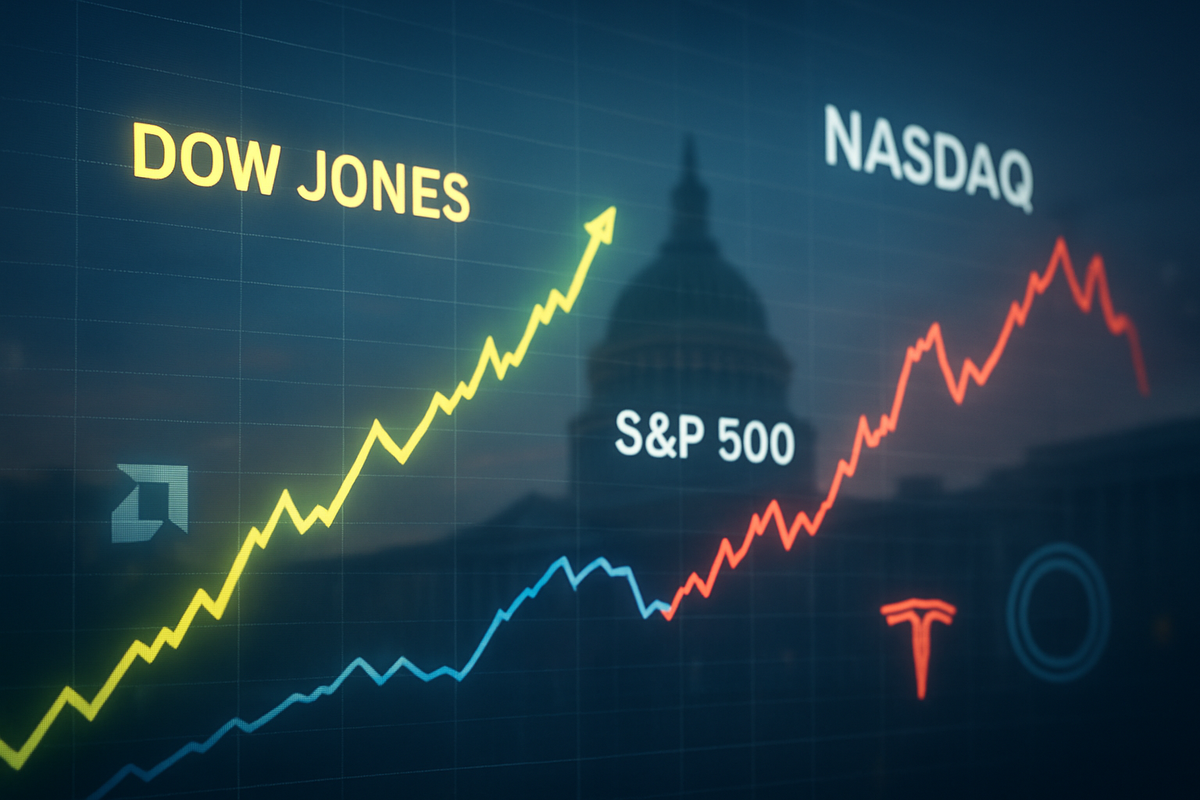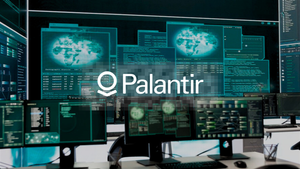
New York, NY – November 12, 2025 – The U.S. stock market presented a landscape of diverging fortunes today, as the Dow Jones Industrial Average surged to new record highs, fueled by mounting optimism for an end to a protracted government shutdown, while the tech-heavy Nasdaq Composite experienced a notable decline. The S&P 500, a broader measure of market health, managed a modest gain, underscoring a cautious yet optimistic sentiment among investors grappling with both political uncertainties and shifting sector dynamics. This mixed performance highlights a market in transition, where traditional industrial and financial sectors are finding renewed vigor, even as the high-flying technology and artificial intelligence (AI) stocks face a period of recalibration and profit-taking.
The day's trading reflected a clear bifurcation in investor confidence. While the prospect of a government resolution injected a much-needed boost into certain segments, particularly financials and industrials, concerns over the lofty valuations of some technology companies, especially those in the AI space, led to a pullback. This dynamic suggests that investors are re-evaluating growth prospects and risk appetites, moving capital towards areas perceived as more stable or undervalued in the current economic climate. The interplay of macroeconomic factors, such as the government shutdown, and microeconomic forces, like sector-specific performance, created a complex trading environment that saw both significant gains and notable losses across the board.
Market Dynamics: A Tale of Three Indices
The trading day on November 12, 2025, was characterized by a distinct divergence among the major U.S. stock indices. The Dow Jones Industrial Average (DJIA), a barometer for blue-chip industrial stocks, was the standout performer, achieving a remarkable surge of 559.33 points, or 1.2%, to close at a record-breaking 47,927.96. This robust ascent was primarily propelled by increasing hopes that the 43-day U.S. government shutdown was nearing its conclusion, with legislative action anticipated to resolve the impasse. Financial giants such as Goldman Sachs (NYSE: GS), JPMorgan (NYSE: JPM), and American Express (NYSE: AXP) all hit fresh record highs, significantly contributing to the Dow's upward trajectory. Additionally, International Business Machines (NYSE: IBM) saw a 2.9% rise following an announcement of advancements in quantum computing, further bolstering the index.
In contrast, the Nasdaq Composite (NASDAQ), heavily weighted with technology and growth stocks, experienced a downturn, shedding 58.87 points, or 0.3%, to close at 23,468.30. This dip was largely attributed to profit-taking within the technology sector, particularly among AI-related companies, as investors began to question the sustainability of their rapid gains. Nvidia (NASDAQ: NVDA), a pivotal player in the AI chip market, saw a 0.6% dip on the day, contributing to the Nasdaq's struggle. The broader sentiment around AI stocks was further dampened by the news that SoftBank Group had divested its entire $5.8 billion stake in Nvidia.
The S&P 500 (SPX), which provides a broader snapshot of the market by tracking 500 large U.S. companies, registered a modest increase of 0.21%, closing at 6,846.61. While not as dramatic as the Dow's ascent, the S&P 500's positive movement indicated underlying strength in certain sectors. Healthcare stocks, including Eli Lilly (NYSE: LLY), Johnson & Johnson (NYSE: JNJ), and AbbVie (NYSE: ABBV), each saw their stock prices increase by over 2%, providing significant support. Gains in other semiconductor companies helped to offset declines in some of the larger tech names within the index, demonstrating a nuanced market where specific sector strength could counteract broader tech sector weakness. The primary catalyst driving the overall market sentiment was the widespread anticipation of an end to the U.S. government shutdown, a development seen as crucial for removing economic uncertainty and fostering a more stable investment environment.
Companies in Focus: Winners and Losers in a Shifting Landscape
Today's market movements brought several prominent companies into sharp focus, revealing clear winners and losers amidst the shifting investor sentiment. Advanced Micro Devices (NASDAQ: AMD) emerged as a significant winner, with its stock rallying impressively by 8.5% by mid-day. This substantial gain followed an optimistic projection from CEO Lisa Su, who forecast an annual compounded revenue growth of over 35% for the next three to five years, largely driven by "accelerating AI momentum." AMD's performance signals continued confidence in the semiconductor industry's role in the AI revolution, positioning it favorably despite broader tech sector anxieties.
Conversely, Nvidia (NASDAQ: NVDA), another titan in the AI chip space, experienced a dip of 0.6% today, extending its monthly decline to 4.6%. This downturn reflects a broader trend of profit-taking in high-valuation AI stocks, as investors scrutinize whether these companies can sustain their meteoric growth. The sentiment around Nvidia was further impacted by the news that SoftBank Group had divested its entire $5.8 billion stake in the company. While Nvidia remains a dominant force in AI, today's performance suggests a period of re-evaluation for investors, who are now more critically assessing the immediate upside potential of highly valued tech leaders.
While specific real-time data for Circle (private company, often associated with USDC) and Tesla (NASDAQ: TSLA) on November 12, 2025, was not immediately available in the broader market overview, their general market context provides insight into how they might be affected. For Circle, as a major player in the stablecoin market, its performance is often tied to the broader health and regulatory landscape of the cryptocurrency market. A mixed stock market and potential economic uncertainty could lead to increased interest in stablecoins as a safe haven, or conversely, a flight from riskier digital assets. Tesla, a bellwether for the electric vehicle (EV) sector and a significant component of the consumer discretionary segment, often reacts strongly to broader economic sentiment, interest rate expectations, and company-specific news regarding production, deliveries, and innovation. In a market where tech stocks are facing profit-taking, Tesla could also experience pressure, especially given its high valuation and sensitivity to market volatility. Its performance would also be influenced by any news related to its ongoing technological advancements, competition, or global market expansion.
The day's trading highlighted a divergence in how different segments of the tech sector are perceived. While companies like AMD, with fresh, strong growth projections, found favor, those like Nvidia, which have already seen immense gains, faced selling pressure. This indicates a more discerning investor approach, prioritizing clear future growth catalysts over past performance, especially in a high-interest-rate environment where the cost of capital is higher and future earnings are discounted more heavily. Companies with robust earnings and clear pathways to continued expansion, particularly those less impacted by immediate economic headwinds, appear to be gaining an edge.
Wider Significance: Navigating Macroeconomic Currents and Tech Revaluation
Today's mixed market performance on November 12, 2025, fits into a broader narrative of economic recalibration and sectoral re-evaluation. The surge in the Dow Jones, largely driven by optimism over a potential end to the U.S. government shutdown, underscores the significant impact of macroeconomic stability on investor confidence. A prolonged shutdown had injected considerable uncertainty into the economy, delaying critical economic data and clouding the Federal Reserve's view of the economic landscape. Its resolution would remove a major headwind, potentially paving the way for clearer economic policy and renewed corporate investment. This event highlights how political developments can profoundly influence market sentiment, often outweighing individual company news in the short term.
The contrasting decline in the Nasdaq Composite, fueled by profit-taking in the technology sector, particularly among AI-related stocks, signals a potential shift in broader industry trends. For months, AI stocks have enjoyed an unprecedented rally, leading to concerns about an "AI bubble" and overstretched valuations. Today's movements suggest that investors are becoming more discerning, moving away from a blanket enthusiasm for all AI-related companies towards a more selective approach. This re-evaluation could have ripple effects across the technology ecosystem, prompting companies to demonstrate tangible earnings and sustainable growth rather than relying solely on future potential. Competitors and partners within the AI space will be closely watching, as a sustained re-rating could alter investment flows and strategic priorities.
From a regulatory and policy perspective, the resolution of the government shutdown would alleviate pressure on various government agencies, allowing them to resume full operations and potentially address other pressing issues, including technology regulation, antitrust concerns, and broader economic policy. The mixed market signals also serve as a reminder of the inherent volatility in modern financial markets, often influenced by a complex interplay of political events, technological advancements, and investor psychology. Historically, periods of rapid technological innovation, like the current AI boom, have often been followed by periods of consolidation and re-evaluation, where market leaders solidify their positions while less robust players struggle. The current scenario bears some resemblance to past tech-driven market cycles, where initial euphoria eventually gives way to a more pragmatic assessment of long-term value.
What Comes Next: Navigating Volatility and Emerging Opportunities
Looking ahead, the immediate short-term outlook for the market will largely hinge on the official resolution of the U.S. government shutdown. If a definitive agreement is reached and implemented, it is likely to provide a further boost to investor confidence, potentially extending the rally in sectors that benefit from economic stability, such as financials and industrials. However, the underlying concerns about inflation, interest rates, and the sustainability of high valuations in certain tech segments will continue to loom large. In the long term, the market is likely to remain in a state of flux, balancing the ongoing enthusiasm for transformative technologies like AI with a more cautious approach to risk and valuation.
For public companies, particularly those in the technology sector, the coming months may necessitate strategic pivots and adaptations. Companies that can demonstrate clear profitability, robust business models, and a sustainable competitive advantage in the AI space are likely to weather any market corrections more effectively. Those with less defined pathways to monetization or highly speculative valuations might face continued pressure. This environment could also create market opportunities for investors seeking value in overlooked sectors or companies that have been unfairly penalized during the tech sector's re-evaluation. Conversely, challenges will emerge for companies heavily reliant on external funding or those whose growth prospects are perceived as overly speculative.
Potential scenarios include a continued rotation of capital out of highly valued growth stocks into more stable, dividend-paying companies or those with strong fundamentals. Another scenario could see a more pronounced correction in the tech sector if earnings reports fail to meet elevated expectations or if macroeconomic headwinds intensify. Investors will be closely watching for signs of economic recovery post-shutdown, any shifts in Federal Reserve policy, and the trajectory of corporate earnings. The emergence of new regulatory frameworks for AI and other advanced technologies could also introduce new variables, shaping the competitive landscape and influencing investor sentiment.
Wrap-Up: A Market in Search of Equilibrium
Today's mixed stock market performance on November 12, 2025, provides several key takeaways for investors and market watchers. Firstly, the significant rally in the Dow Jones Industrial Average underscores the profound impact of political stability on investor confidence, demonstrating how the resolution of major uncertainties can unlock substantial market gains. Secondly, the decline in the Nasdaq Composite, alongside profit-taking in leading AI stocks like Nvidia, signals a crucial re-evaluation within the technology sector. This suggests a move towards a more discerning investment approach, where fundamental strength and sustainable growth trajectories are increasingly prioritized over speculative potential.
Moving forward, the market will likely remain in a state of dynamic equilibrium, continuously adjusting to new economic data, corporate earnings reports, and geopolitical developments. Investors should prepare for continued volatility and be vigilant in assessing both opportunities and risks. The divergence between traditional industrial and financial stocks performing well, and certain tech stocks facing headwinds, highlights a potential rotation of capital that could redefine market leadership in the coming months.
What investors should watch for in the coming months includes the full economic impact of the government shutdown's resolution, any shifts in Federal Reserve monetary policy, and the upcoming corporate earnings season, particularly from technology companies. The performance of key AI players like AMD and Nvidia will be critical indicators of sentiment within the tech sector. Furthermore, developments in the broader cryptocurrency market could influence companies like Circle, while Tesla's production figures and innovation announcements will continue to shape the narrative for the EV sector. A balanced and diversified investment strategy, coupled with a keen eye on both macroeconomic trends and company-specific fundamentals, will be essential for navigating the evolving market landscape.
This content is intended for informational purposes only and is not financial advice





